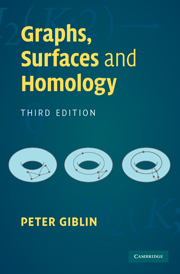Book contents
- Frontmatter
- Contents
- Preface to the third edition
- Preface to the first edition
- List of notation
- Introduction
- 1 Graphs
- 2 Closed surfaces
- 3 Simplicial complexes
- 4 Homology groups
- 5 The question of invariance
- 6 Some general theorems
- 7 Two more general theorems
- 8 Homology modulo 2
- 9 Graphs in surfaces
- Appendix: abelian groups
- References
- Index
3 - Simplicial complexes
Published online by Cambridge University Press: 05 June 2012
- Frontmatter
- Contents
- Preface to the third edition
- Preface to the first edition
- List of notation
- Introduction
- 1 Graphs
- 2 Closed surfaces
- 3 Simplicial complexes
- 4 Homology groups
- 5 The question of invariance
- 6 Some general theorems
- 7 Two more general theorems
- 8 Homology modulo 2
- 9 Graphs in surfaces
- Appendix: abelian groups
- References
- Index
Summary
The reader may have noticed that although surfaces are constructed out of triangles I did not define the word ‘triangle’ in Chapter 2. Doubtless the reader has come across triangles before. Nevertheless a precise definition in terms suited to our purpose is given below, where triangles appear under the alias of ‘2-simplexes’. The precise definition makes it clear that ‘triangle’ is a good way to continue the sequence ‘point, segment, …’ (which becomes ‘0-simplex, 1-simplex, …’) and suggests that the fourth term should be ‘solid tetrahedron’: this is our three-dimensional building block. We shall need building blocks in higher dimensions too, but most examples in the text will be, as hitherto, two dimensional. Algebraic concepts closely analogous to the cycles of Chapter 1 will be introduced in Chapter 4.
It is possible, by judicious skipping in this chapter, to avoid contact with simplexes of dimension higher than two. All initial definitions are stated for the case of two dimensions as well as in general; from 3.9 just assume n ≤ 2.
Everything in the chapter takes place in a real vector space ℝN. Elements of ℝN are called points or vectors. Unless otherwise stated the only restriction on N is that it should be large enough for the discussion to make sense; thus if we speak of four non-coplanar points then obviously N must be at least 3.
Simplexes
It is clear that two points v0 and v1 are the end-points of a segment if and only if they are distinct.
- Type
- Chapter
- Information
- Graphs, Surfaces and Homology , pp. 67 - 98Publisher: Cambridge University PressPrint publication year: 2010



